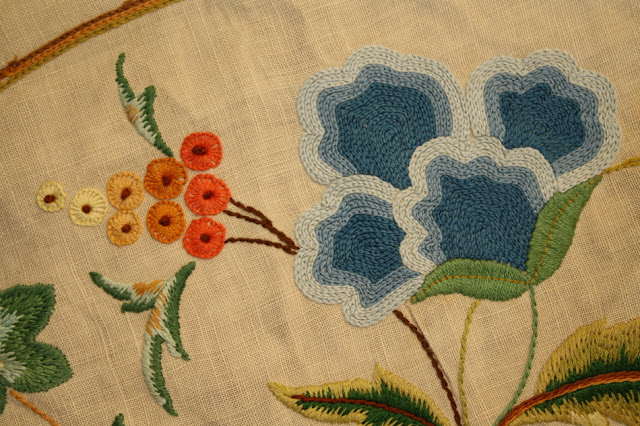Hallo my embroidery loving darlings, I thought I would show you some of my latest finds on Trade Me. Of course they are all embroidery pieces, which seems to have taken over my creative life at the moment, but there is tailoring and ruff making on the horizon.
 |
| Berlin work cushion: C1850 - 1870 |
This type of embroidery is often called tapestry, but tapestry is a woven fabric with an intermittent weft thread, however the term tapestry is still in general use today for work such as this.
If you want to see some really amazing modern day tapestry check out this workshop in Victoria, Australia.
The cushion above is an example of Berlin work.
In 1804-5 a print seller in Berlin named Phillipson, published the first coloured design for needlework, on checked paper.
Berlin work was popular from the beginning of the 19th century to the 1870’s.
The patterns were engraved onto copper plates and printed onto point (graph or squared) paper. Each small square representing one stitch contained a symbol indicating which colour of wool to use.  The patterns were hand-coloured using watercolour paint, following the symbols. A small block of each colour was painted down the side of the point paper for reference when purchasing the wools. Men women and children were employed to colour the designs, and were paid a pittance compared to the retail cost of the patterns in needlework shops. Gail Marsh records in her book, 19th Century Embroidery Techniques, that “The German designs were sold all over Europe, Scandinavia, Russia and America”, but it would appear that they also made their way to New Zealand. As monthly magazines and journals, such as The Englishwomen’s Domestic Magazine and The Young Ladies Journal, became more available, Berlin wool work patterns were enclosed as a free gift, but these designs were colour printed and of an inferior quality.
The patterns were hand-coloured using watercolour paint, following the symbols. A small block of each colour was painted down the side of the point paper for reference when purchasing the wools. Men women and children were employed to colour the designs, and were paid a pittance compared to the retail cost of the patterns in needlework shops. Gail Marsh records in her book, 19th Century Embroidery Techniques, that “The German designs were sold all over Europe, Scandinavia, Russia and America”, but it would appear that they also made their way to New Zealand. As monthly magazines and journals, such as The Englishwomen’s Domestic Magazine and The Young Ladies Journal, became more available, Berlin wool work patterns were enclosed as a free gift, but these designs were colour printed and of an inferior quality.
 The patterns were hand-coloured using watercolour paint, following the symbols. A small block of each colour was painted down the side of the point paper for reference when purchasing the wools. Men women and children were employed to colour the designs, and were paid a pittance compared to the retail cost of the patterns in needlework shops. Gail Marsh records in her book, 19th Century Embroidery Techniques, that “The German designs were sold all over Europe, Scandinavia, Russia and America”, but it would appear that they also made their way to New Zealand. As monthly magazines and journals, such as The Englishwomen’s Domestic Magazine and The Young Ladies Journal, became more available, Berlin wool work patterns were enclosed as a free gift, but these designs were colour printed and of an inferior quality.
The patterns were hand-coloured using watercolour paint, following the symbols. A small block of each colour was painted down the side of the point paper for reference when purchasing the wools. Men women and children were employed to colour the designs, and were paid a pittance compared to the retail cost of the patterns in needlework shops. Gail Marsh records in her book, 19th Century Embroidery Techniques, that “The German designs were sold all over Europe, Scandinavia, Russia and America”, but it would appear that they also made their way to New Zealand. As monthly magazines and journals, such as The Englishwomen’s Domestic Magazine and The Young Ladies Journal, became more available, Berlin wool work patterns were enclosed as a free gift, but these designs were colour printed and of an inferior quality. The Berlin thread was known as Zephyr and was made from merino wool. It was spun in Gotha Germany and dyed in Berlin. The thread was lightly twisted, had a good loft and covered the canvas well. It came in a good range of colours but was not strong, and needed to be used in short lengths. Berlin work was often worked with tiny seed beads, along with the wool.
 |
| Unfinished cushion cover worked in a modern day interpretation of Old English Crewel embroidery. |
In the 17th and 18th century there was a great vogue for hangings, bedspreads, and large curtains, embroidered in wools on linen twills. Many of the designs were inspired by work brought from the East by intrepid travellers who were establishing trade routes with foreign countries.
Can you identify some of the stitches?
I see chain stitch and stem stitch.
The little orange and yellow flowers are executed in a buttonhole stitch.
This lovely piece of canvas work, has been worked in a tent stitch, a simple diagonal stitch.
The verso of the canvas shows the original colours the embroidery was worked in.
See how the ends of the threads are threaded through the back of the canvas rather than knotted off.
So my precious darlings I hope you have learned a little something and read all the text, because you know how much I love book loving darlings.
References for this post:
Weldon's Encyclopaedia of Needlework
and
Reader's Digest Complete Guide to Needlecraft
19th Century Embroidery Techniques, by Gail Marsh










The unfinished cushion cover is exquisite. Would look beautiful in a nice white frame...
ReplyDeleteSo are you saying it is art?
ReplyDelete